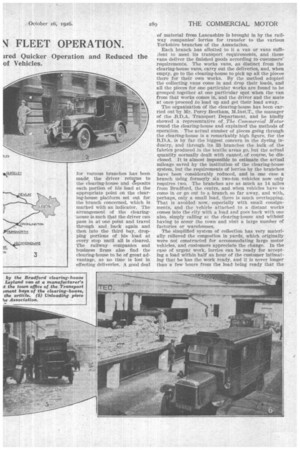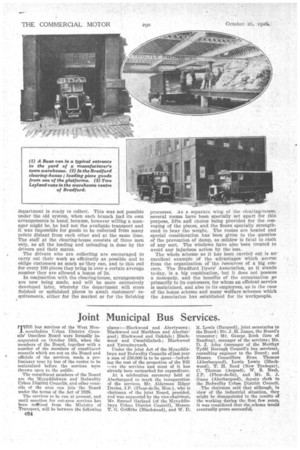ENSURING EFFICIENC
Page 54

Page 55

Page 56

If you've noticed an error in this article please click here to report it so we can fix it.
N. FLEET OPERATION. How the Bradford Dyers' Associaq-on ha!
Size of its ired Quicker Operation and Reduced the of Vehicles.
fr HE problem of preventing light or empty running
of vehicles and the organization of satisfactory collection and delivery services have been very closely considered by the Bradford Dyers' Association, the important and extensive Yorkshire and Lancashire concern whoseactivities spread over the whole of the worsted and cotton manufacturing districts of the North of England. At both Bradford and Manchester steps recently taken have led to a very considerable reduction in the total mileage run by vehicles employed by the Association. Central clearing-houses have been established, and the result has been a complete reorganization of the system of collecting undyed and unfinished pieces which are dealt with by the various branches of the Association at a number of factories scattered over a wide area.
The accompanying map shows the location of the West Yorkshire branches of the Association and indicates the collecting area served by the Bradford clearing-house. The regular area of collection is bounded by Keighley, Haworth, Denholme, Thornton, Queensbury, Halifax, Wyke, Drighlington, Leeds, Burley and Bingley, and embraces all the towns within that area.
Each branch concentrates on a particular class of work, and it is the duty of the central transport department in Bradford to organize the whole of the transport of the Association and to maintain the large fleet of motor vehicles which is kept in service. The central garage and workshops of the transport department were described in The Commercial Motor some time ago, but since then the clearing-house system has been developed and a capacious building has been converted for use in connection therewith. The clearing-house adjoins the newly opened garage and transport offices in Thornton Road and Norcroft Street, and comprises three bays, with roadways to enable the vehicles to run straight through. These roadways are each 21 ft. wide and allow vehicles to unload at platforms on each side or two vehicles to discharge when standing side by side. In the three bays there is, roughly, 250 yards of loading space, and this distance is divided into sections for each of the branches of the Association.
Formerly each branch works arranged for the collection of its own goods from customers, and some customers did business with as many as six or seven branches, so that there was a possibility of half a dozen B.D.A vans being in a manufacturer's yard almost at one arid the same time. Now the whole of the collecting of " greys " is done by the clearing house. The Bradford clearing-house has in use eight 2-ton Leyland vans, one 1-ton Fiat and one 10-15cwt. Maxwell, and these collect not only in Bradford, but in Leeds, Keighley, Shipley and Halifax, and as far up the valley of the Wharfe as Burleyin-Wharfedale. Each driver is allotted a particular round, and he is given instructions where consignments are to 'be picked up. Sometimes a driver will find that one customer has a full load for one particular branch. In that ease he delivers direct to the branch concerned without returning to the clearing-house, but when a collection of a number of pieces for various branches has been made, the driver returns to the clearing-house and deposits each portion of his load at the appropriate point on the clearing-house platform set out for the branch concerned, which is marked with an indicator. The arrangement of the clearing'house is such that the driver can pass in at one point and travel through and back again and then into the third bay, dropping portions of his load at every stop until all is cleared. The railway companies and business firms also find the clearing-house to. be of great advantage, as no time is lost in effecting deliveries. A good deal of material from Lancashire is brought in by the railway companies' lorries for transfer to the various Yorkshire branches of the Association.
Each branch has allotted to it a van or vans suffiAnt to meet its transport requirements, and these vans deliver the finished goods according to customers' requirements. The works vans, as distinct from the clearing-house vans, carry out the deliveries, and, when empty, go to the clearing-house to pick up all the pieces there for their own works. By the method adopted the collecting vans come in and drop their loads, and all the pieces for one particular works are found to be grouped together at one particular spot when the van from that works comes in, and the driver and the mate at once proceed to load up and get their load away.
The organization of the clearing-house has been carried out by Mr. Percy Beetham, M.Inst.T., the manager of the B.D.A. Transport Department, and he kindly showed a representative of The Commercial Motor round the clearing-house and explained the methods of operation. The actual number of Pieces going through the clearing-house is a remarkably high figure. for the B.D.A. is by far the biggest concern in the dyeing industry, and through ita 33 branches the bulk of the fabrics produced in the textile areas go, but the actual quantity normally dealt with cannot, of course, be disclosed. It is almost impossible to estimate the actual mileage saved by the institution of the clearing-house system, but the requirements of lorries by the branches have been considerably reduced, and in one ease a branch using formerly . six two-ton vehicles now only requires two. The branches are as much as 14 miles from Bradford, the centre, and when vehicles have to come in or go out to a branch so far away, and with, perhaps, only a small load, there is much overlapping. That is avoided now, especially with small consignments, and the vehicle attached to a distant works comes into the city with a Toad and goes back with one also, simply calling at the clearing-house and withOut having to scour the town and visit a large number of factories or warehouses.
The simplified system of collection has very materially relieved the congestion in yardS, which originally were not constructed for accommodating large motor vehicles, and customers appreciate the change. In the case of urgent work, lorries can be ready for accepting a load within half an hour of the customer intimating that he has the work ready, and it is never longer than a few hours from the load being ready that the department is ready to collect. This was not possible under the old system, when each branch had its own arrangements in hand; because, however willing a manager might be, he had not the available transport and it was impossible for goods to be collected from many points distant from each other and at the same time. The staff at the clearing-house consists of three men only, as all the loading and unloading is done by the drivers and their mates, The drivers who are collecting are encouraged to carry out their work as efficiently as possible and to oblige customers as much as/they can, and to this end for every 100 pieces they bring in over a certain average number they are allowed a bonus of 2s.
In conjunction with the clearing-house, arrangements are now being made, and will be more extensively developed later, whereby the department will store finished or unfinished pieces to await customers' requirements, either for the market or for the finishing
processes. As a separate wing or •the clearing-noose, several rooms have been specially set apart for this purpose, lifts and chutes being provided for the conveying of the pieces, and the floors, specially' strengthened to bear the weight.. The rooms are heated and special consideration has been given to the question of the prevention of damp, as mildew is fatal to cloth of any sort. The windows have also been treated to avoid any injurious action by the sun.
The whole scheme as it has been carried out is an excellent example of the advantages which accrue from the organization of the resources of a big concern. The Bradford 'Dyers' Association, as it stands to-day, is a big combination, but it does not possess a monopoly, and the benefits of the organization go primarily to its customers, for whom an efficient service is maintained, and also to its employees, as in the case of the bonus scheme and many welfare schemes which the Association has established for its workpeople.




































































































